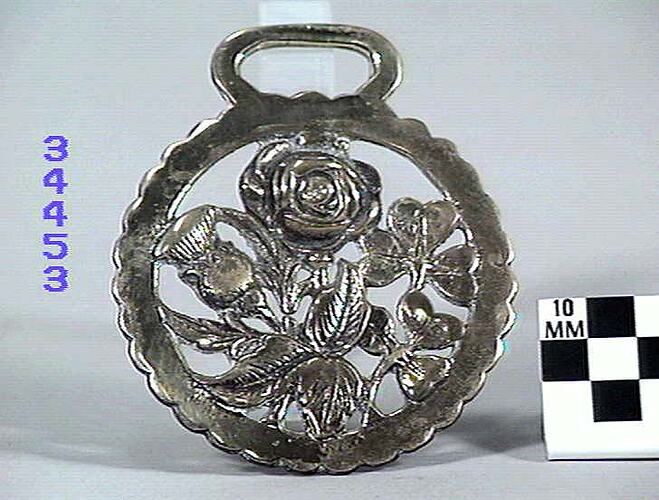Summary
Horse brass: National emblems of England, Ireland, Scotland and Wales (the rose, shamrock, thistle and leek). Crenate border. Type: cast brass. Date: 1825-1939.
The rose, the national emblem of England, symoblises the chalice of life, the soul, the heart and love. They are also associated with symbols of mystical rebirth and regeneration.
The shamrock, the national emblem of Ireland, is a triple-leaf shape which symbolises the Trinity.
The thistle is the national emblem of Scotland and represents "a symbol of the protective belt defending the heart against external harm and attacks. The device of Scotland is 'Nemo me impune lacessit' (None touches me unharmed)." (See: 'Pengiun Dictionary of Symbols')
"St. David is the patron saint of Wales. He was a monk who lived on bread, water, herbs and leeks and died on March 1, 589 A. D. The leek had been recognised as the emblem of Wales since the middle of the 16th century. Its association with Wales can in fact be traced back to the battle of Heathfield in 633 AD, when St. David persuaded his countrymen to distinguish themselves from their Saxon foes by wearing a leek in their caps." (See: http://www.informationwales.co.uk/).
More Information
-
Collecting Areas
-
Acquisition Information
Donation from Mr W. J. Haysom, 30 Jun 1982
-
Date Made
England, Great Britain, 1825-1939
Cast horse brasses were first made in 1825, and following the introduction of motor vehicles and decline in horsedrawn transport, regular production ceased in the 1930s. -
Classification
-
Category
-
Discipline
-
Type of item
-
References
[Link 1] viewed, 23.05.2008 LDH [Link 2] viewed, 23.05.2008 LDH [Link 3] viewed, 23.05.2008 LDH [Link 4] viewed, 23.05.2008 LDH
[Book] Chevalier, Jean & Gheerbrant, Alain. 1994. The Penguin Dictionary of Symbols., 1994
-
Keywords
Amulets, Animals, Cultural Beliefs, Folklore, Harnesses, Heraldry, Horse Brasses, Rituals, Souvenirs, Symbols
